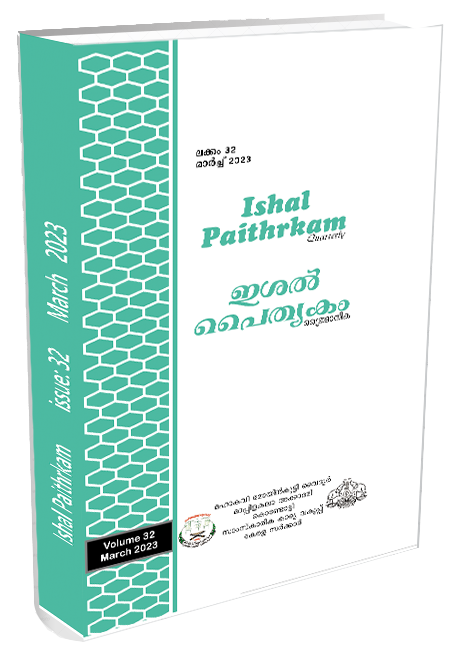Fashioning ‘Body’: Sartorial Reforms and Namboothiri Women
Keywords:
Women, middle-class, patriarchy, dress reforms, antharjana samajamAbstract
Clothing patterns have been a gendered expression of individual’s identity throughout history. Societal concerns always played a major role in the making of sartorial choices. Morality and modesty were integral to clothing culture; when it comes to women, patriarchy was very cautious of the moral underpinnings of dress. Patriarchal notions were explicit in the traditional clothing style of women in every community. However, the ‘middleclass’ conviction was not in favour of continuing the traditional clothing patterns of women and sought to reform the same. The reformism again was in tune with the ‘new patriarchy’ and set out to ‘modernize’ women to cater the needs of new found patriarchy. This paper addresses the sartorial amelioration of Namboothiri women proposed by the male reformers of the community and how they conceived women in new attire.
Downloads
References
Bannerji, H. (2001), Inventing Subjects- Studies in Hegemony, Patriarchy and Colonialism, New Delhi: Tulika Books
Bhattathiripad, V.T., (2015), Karmavipakam, V.T. yude Sampoorna Krithikal, Kottayam: D.C.Books.
Chakravarthi, U. , (2013), Gendering Caste Through Feminist Lens, Calcutta: Sage Publication
Das, V., (1976), Indian Women: Work. Power and Status, B.R. Nanda (ed.) Indian Women, Noida: Vikas Publishing House
De Beauvoir, S., (1953), The Second Sex, Berkshire, London: Jonathan Cape
Devika, J., (2005), The Asthetic Women – Reforming female bodies and minds in early 20th century Keralam, Modern Asian Studies, 39(2), 461-487
Fischer, G. V., (2001), Pantaloons and Power: A Nineteenth Century Dress Reform in United States, Kent: The Kent State University Press.
Gupta, C., (2012), Fashioning’ Swadeshi – Clothing Women in Colonial India, Economic and Political Weekly, vol.47, no. 42
Namboothiripad, M.B., (1926), ‘Poorvacharam Adava Keezhnadappu II’, Unnninamboothiri, vol. 7, issue. 11, 647-654.
Nenmenimangalam, P., (1933), Streetvam, Stree, , vol.1, issue. 1, pp.15-16, in Devika, J (2005), Her-Self Early Writings on Gender by Malayalee Women 1898-1938, Stree, Calcutta
Nilayangode, D., (2011), Antarjanam Memories of a Namboothiri Woman (Translated form Malayalam by Indira Menon and Radhika Menon) New Delhi: Oxford University Press.
Omolade, B., (1983), “Hearts of Darkness”. In Ann Snitow, Christine Stansell, and Sharon Thompson (ed.), Powers of Desire: The Politics of Sexuality, New York: Monthly Review Press, 350–367
Pal, D.,(1911), The Hindu Wife, Calcutta: Phanindra Nath Pal.
Rajeevan, B., (1999), From caste to sex: A study on sexuality and the formation of modern subject in Kerala, M.A. Oommen Institute of Social Science, New Delhi: Concept Publishing Company.
Riegel, R. E.,( 1963), Women’s Clothes and Women’s Rights, American Quarterly, 15, no.3, 603- 617
Schildt, H. , (2012), The Traditional Kerala Manor: Architecture of a South Indian catushala house, Pondicherry: French institute.
Sen, I., (2002), Woman and Empire: Representations in the Writings of British India, 1858-1900, Hyderabad: Orient Blackswan
Staples, K. A & Shaw, M. C. , (2013), Clothing through American History: The British Colonial era, California: ABC-CLIO
Thurston, E.,( 1909), Castes and tribes of Southern India, volume V-M to P, Chennai: Government Press Madras
V. R., (2015), Aryadhiniveshavum Namboothirisamskaravum, Kottayam: Sahitya Pravarthaka Co-operative Society.
Wilton , S., (2012), Bound from head to toe – Sari as an expression of Gendered National Identity, Studies in ethnicity and Nationalism, vol.12, issue 1, 190-205.
Downloads
Published
Issue
Section
License
Copyright (c) 2025 ISHAL PAITHRKAM

This work is licensed under a Creative Commons Attribution 4.0 International License.

